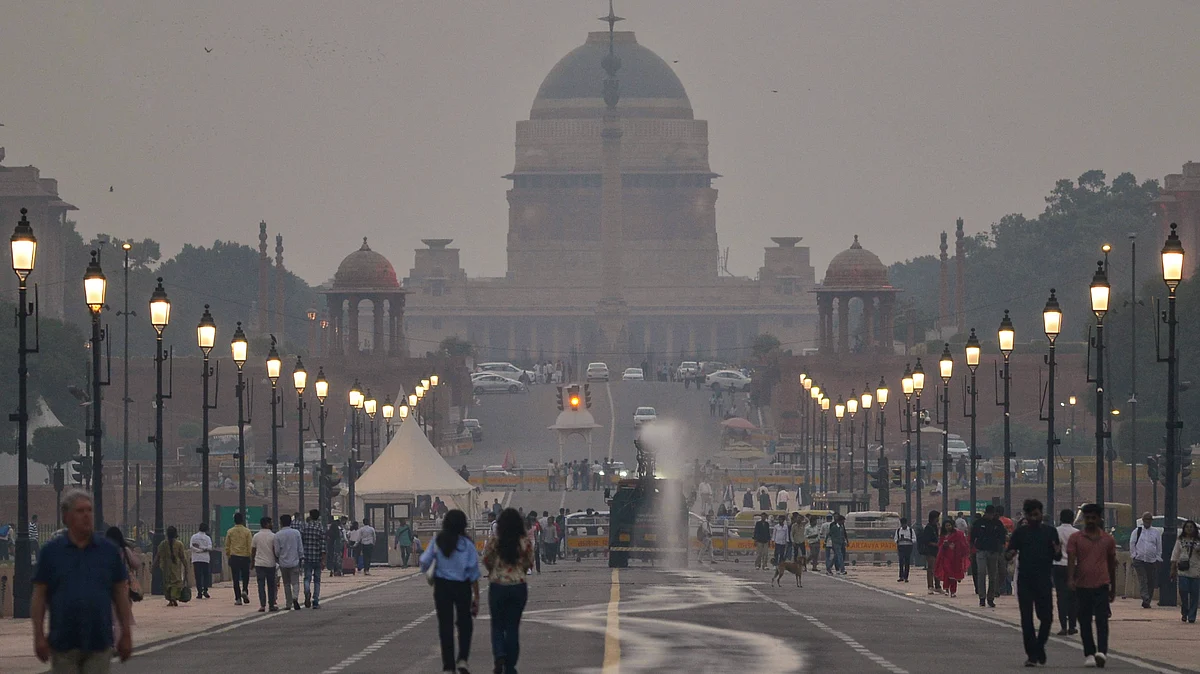Delhi's AQI figures sparks debate day after civic body caught manipulating data
While dust suppression efforts expand along key corridors, controversy over alleged AQI data manipulation sparks debate on transparency and pollution control measures in the capital

Despite the New Delhi Municipal Council’s (NDMC) ambitious rollout of mist sprayers along Shanti Path and Africa Avenue, Delhi’s air quality stubbornly remains in the ‘very poor’ category, raising questions about the efficacy of such piecemeal interventions. While spraying treated water may temporarily suppress dust, experts warn that these efforts alone are insufficient to tackle the city’s deep-rooted pollution crisis exacerbated by vehicular emissions, industrial activity and rampant construction.
Compounding the situation is a fresh political controversy over alleged manipulation of air quality index (AQI) data near monitoring stations. Videos circulating on social media showing water tankers sprinkled near the Anand Vihar monitoring site have sparked accusations of data tampering to artificially lower pollution readings. This raises disturbing concerns about transparency and accountability, undermining public trust at a time when Delhi desperately needs credible, sustained, and science-based pollution control measures.
NDMC Chairperson Kuljeet Singh Chahal said the civic body was intensifying measures aimed at improving air quality, enhancing greenery, and promoting public awareness. The latest initiative follows what officials called a “successful first phase” along Lodhi Road.
Mist sprayers mounted on electric poles release fine droplets of treated water to help settle dust and airborne pollutants while also watering roadside plants. “Team NDMC is committed to the prime minister's vision of a clean and green India and to ensuring a healthier environment for citizens,” Chahal said.
The system currently covers 30 poles with five nozzles each along an 850-metre stretch of Africa Avenue and 32 poles over 900 metres on Shanti Path, with each pole using about 84 litres of treated water per hour. A third phase, costing Rs 15 crore, will cover 24 major roads in the NDMC area, followed by a fourth phase extending to Connaught Place and Khan Market.
Data manipulation doesn't spare AQI
However, even as local bodies rolled out pollution-control measures, a fresh controversy erupted over alleged manipulation of air quality readings.
A video posted by AAP Delhi chief Saurabh Bharadwaj on Saturday showed two Municipal Corporation of Delhi (MCD) tankers spraying water near the Anand Vihar air quality monitoring station, triggering a political row. Bharadwaj accused the BJP government of attempting to artificially lower AQI levels around the sensors.
“BJP Government – Pollution Data Fraud. Water is being sprayed day and night at the Delhi pollution monitoring station to reduce the pollution and AQI readings. These are the same people who say there is no dishonesty in EVMs. When they engage in dishonesty in everything, what can be expected from them?” he wrote on X.
Government officials, however, denied the allegation, saying water sprinkling is a standard anti-dust measure carried out across the city. “The same is being done at Anand Vihar,” a senior official said, citing the deployment of 376 anti-smog guns, 266 water sprinklers, and 91 mechanical road-sweeping machines. Officials said 311 inspections of illegal dumping sites were conducted, with action taken in 173 instances.
Experts cautioned that while sprinkling helps settle dust — a major contributor to PM10 concentrations — doing so next to a monitoring station can momentarily lower readings within a small radius, potentially creating a misleading picture of air quality.
The Anand Vihar station, one of Delhi’s most polluted spots due to its railway station, inter-state bus terminal, and congested roads, recorded an AQI of 431 (“severe”) at 9 pm on Saturday, while most other stations reported “very poor” or “poor” levels.
Meanwhile, NDMC officials said that along with mist sprayers, they are focusing on green belt expansion and citizen participation campaigns to sustain improvements. “Our strategy goes beyond dust control — it includes long-term green infrastructure and public awareness to make Delhi’s air cleaner,” Chahal added.
Follow us on: Facebook, Twitter, Google News, Instagram
Join our official telegram channel (@nationalherald) and stay updated with the latest headlines
